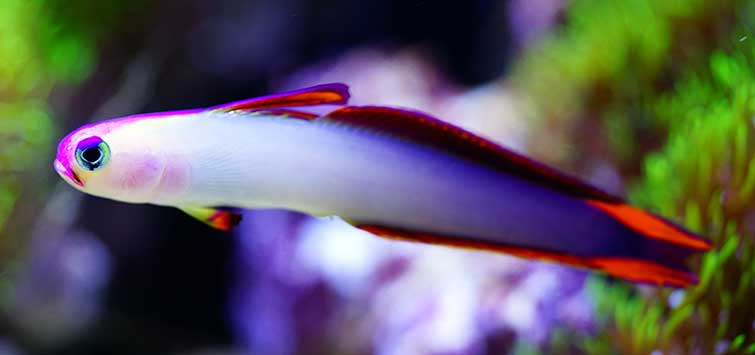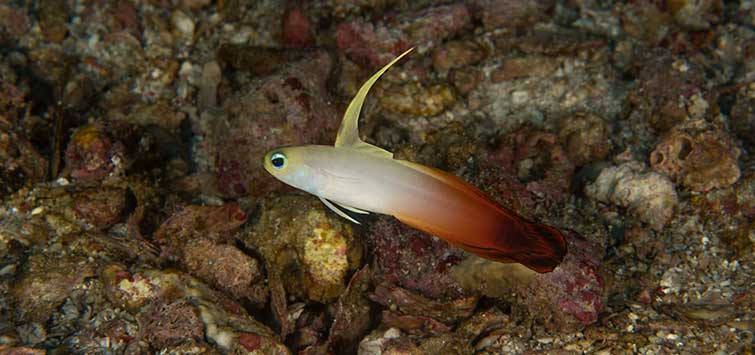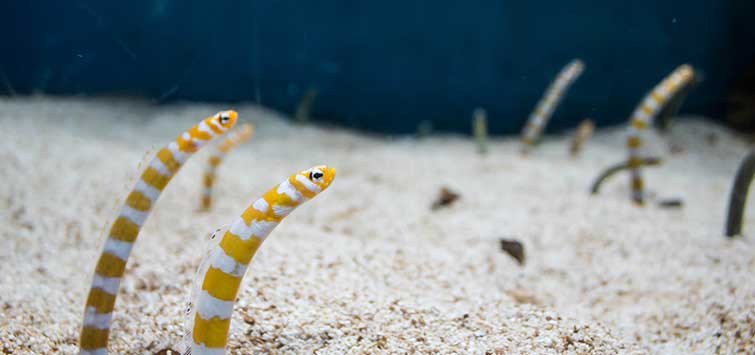Let’s Play Darts! Marine Dartfish
Author: Daniel Pomfret
With slender bodies and fin rays that resemble flights on a dart, as well as their tendency to dart into any available retreat at the first sign of trouble, these little marines couldn’t be more appropriately named. Their interesting behaviors, colorful looks, and reef-safe habits make them a desirable addition to most saltwater setups.
Fish to Target
Named for their defensive burrow-retreating behavior and filamentous fin rays resembling flights found on a dart or arrow, dartfish are small and peaceful fish whose brilliant colors make them excellent candidates for the home aquarium. With a little consideration and planning, it is relatively easy to keep these flashy fish, which make great display animals for beginner to advanced hobbyists.
Dartfish Background
Dartfish are members of the suborder Gobioidei (gobies and their relatives) and the family Microdesmidae. They also belong to the subfamily Ptereleotrinae with five other genera (Rennis and Hoese, 1987), two of which (Ptereleotris and Nemateleotris) are regularly available for the hobbyist. Dartfish are also commonly called wormfish, firefish, and ribbon gobies. They have elongated body structures and extended fin rays. Most are limited to a few inches in size and can be found throughout the entire Indo-Pacific region.
Natural habitats for dartfish consist of sandy bottoms with rocky and rubbly slopes in depths that range from a shallow 5 feet to a rather deep 200 feet for some species. Juveniles are frequently found in groups, which are often quite large with up to 200 individuals, but most species will pair up with a partner when mature. All species possess a retreat burrow, but they do not make their own. Instead, they utilize those dug by worms, mollusks, shrimps, and other sand gobies. These burrows are also used as overnight shelters.
Boarding a Dartfish
Housing requirements for dartfish vary, but aquarium capacities should be 25 gallons and larger, though I have seen dartfish housed in 15-gallon micro reef tanks without ill effects. However, this kind of setup can lead to unstable water quality parameters if not maintained daily. Normal water quality parameters include a temperature range of 73° to 78°F, specific gravity at 1.020 to 1.025, and a pH of 8.1 to 8.4, which is sufficient for all species.
Aquascaping
Aquascaping should consist of deep sandy bottoms with many rocky retreats. The addition of artificial burrows using hidden PVC piping within the lower sections of the rock work well. A sand bed is also an excellent way to make dartfish more comfortable. Dartfish are also completely reef-safe and will not bother corals or other invertebrates. Due to their sometimes wary and jumpy nature, aquariums should have lids if possible. When dartfish are first introduced to the aquarium, you should provide dim lighting and allow slow acclimatization to new specimens before any bright lighting is used.
Tankmates
Choosing tankmates requires significant consideration. Large and active fishes can intimidate dartfish, which leads to abnormal behavior, stress, and starvation. Their delicate fins can also be nipped by more aggressive fishes. To ensure a more active display, they should not be kept with fishes such as angelfish, parrotfish, puffers, rabbitfish, surgeonfish, triggerfish, and some wrasses. They would also become a small meal if kept with eels, scorpionfish, soapfishes, and snappers. Therefore, dartfish are best kept with smaller peaceful fishes like anthias, assessors, cardinals, comets, chromis, dragonets, fairy wrasses, gobies, and jawfish.
Diet and Disease
All dartfish are strict diurnal planktivorous feeders. Their natural feeding behavior consists of hovering a few feet above their burrow to capture plankton suspended in the water column, then quickly darting back to their burrow after getting a bite. In the aquarium, they need regular daily feedings two to three times a day. They will accept frozen and live copepods, amphipods, rotifers, and mysid shrimp.
Vitamin-enriched brine shrimp can also be a great supplement, and, over time, they will accept finely chopped prepared food and dried foods, such as marine flake. It is also a good idea to incorporate a fishless refugium within the system to supply a continuous production of natural plankton.
If given superb water quality and an immune-boosting diet, dartfish are relatively disease resistant, though they can contract some infections like ich and cloudy eye if their immune system is lowered. Treatments are difficult because these fish do not tolerate common therapies very well. Metals like copper and organic dyes could be lethal. Some antibiotics and hyposalinity methods may help, but improving their environment is the best option. Also, do not confuse their habit of regularly flicking and twitching their fin rays as a sign of disease, as this is normal communicative behavior.
Beginner’s Species
Let’s meet some beginner’s species that are commonly available to the hobbyist:
Nemateleotris magnifica
The red or fire dartfish lives in the shallows, occurring in depths from 5 to 15 feet. It grows up to 3 inches in size, and can be found in waters from East Africa to the Hawai‘ian and Pitcairn Islands, north to the Ryukyu Islands, south to New Caledonia and the islands of French Polynesia, and throughout Micronesia. Though they are very peaceful to one another in the wild (several often share the same burrow), this is generally not true in the home aquarium, where they should only be kept individually or in pairs due to aggressive behavior toward each other.
Nemateleotris decora
The purple or elegant dartfish has a maximum size of 3½ inches. It can be found in waters from Mauritius to Samoa, north to the Ryukyu Islands, and south to New Caledonia. It occurs in depths greater than 80 feet. This is probably the most aggressive dartfish—it should be housed individually or in male-female pairs only.
Ptereleotris evides
The scissortail or blackfin dartfish has a bluish gray to white front and a dark posterior body. It grows to a maximum size of 5½ inches and can be found in varying depths from 7 to 50 feet from the Red Sea and East Africa to the Line and Society Islands, north to the Ryukyu and Ogasawara Islands, and south to Eastern Australia. They can be kept in pairs or in small groups.
Ptereleotris zebra
The zebra dartfish or barred dartfish has a light green body with vertical orange to pink stripes down their entire length. They usually grow to about 4 inches. In the wild, they are found in depths up to 200 feet and have a distribution from the Red Sea and islands in the western Indian Ocean to the Line and Marquesas Islands, north to the Ryukyu Islands, south to the Australian eastern coast, and the islands of Micronesia. In the aquarium, they can be kept in small groups if introduced simultaneously. Apart from their retreat requirements, they also enjoy plenty of swimming room. This species is the only member of the dartfish family to have spawned in captivity.
References & Resources
Burgess, W. E., et al. 1991. Dr. Burgess’s Mini-Atlas of Marine Aquarium Fishes, Mini-Edition. T.F.H. Publications, Neptune City, NJ. 1023 pp.
Michael, S. W. 2001. Marine Fishes: 500 + Essential-To-Know Aquarium Species. TFH/Microcosm Professional Series, Neptune City, NJ. 448 pp.
Randall, J. E. and D. F. Hoese. 1985. “Revision of the Indo-Pacific dartfishes, genus Ptereleotris (Perciformes: Gobioidei).” Indo-Pacific Fishes 7:1–36.
Randall, J. E., G. R. Allen & R. C. Steene. 1990. Fishes of the Great Barrier Reef and Coral Sea. University of Hawaii Press, Honolulu & Crawford House Press, Honolulu, Hawaii. 507 pp.
Schultz, H. C. 2007. “Worms Not Found in the Sandbed: The Genus Ptereleotris.” Reefkeeping: www.reefkeeping.com/issues/2003-06/hcs3/index.php
WetWebMedia: www.wetwebmedia.com
See the full article on TFH Digital http://www.tfhdigital.com/tfh/200812/#pg93

.png?h=595&iar=0&w=2781&hash=5FD5E69473BCC22199FBFA2FB71B6033)



